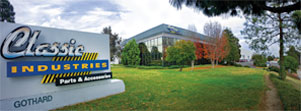
Ever since the earliest days of the automobile, manufacturers have been experimenting with alternatives to the tried-and-true four-stroke internal combustion engine. Some notable alternative powertrains include the Wankel rotary, hydrogen fuel cell, and plug-in battery-powered electric motor. But back in the early 1960s, Chrysler released a vehicle with a drivetrain that seemed truly out of this world: the Turbine Car. Powered by an A-381 turbine that could run on unleaded gas, diesel, kerosene, or JP-4 jet fuel, it was a true "alternative fuel" vehicle. And it wasn't just a one-off concept — 50 cars were built and released to the public.
Photos courtesy of Hagerty Drivers Foundation
The History of the Chrysler Turbine Car

Above: A Chrysler Turbine Car on display at the 1964 New York World's Fair (Photo via Wikipedia, CC BY 3.0)
Like many American automakers, Chrysler began contributing to the war effort during WWII by working on military vehicles and components. This included a division working on turbine engines led by engineer George Huebner. After the end of the war, Huebner and his team continued working on turbine engines as a potential alternative to piston engines in cars, noting their smooth and luxurious power delivery, reduced moving parts, and multi-fuel capability.

Above: Unlike a jet engine, which uses directed thrust to move a vehicle, the Chrysler gas turbine engine used an output shaft to turn gears. It was paired with a traditional automatic transmission.
Throughout the 1950s, these turbine cars were tested and revised — Huebner even drove a prototype from New York City to Los Angeles in four days as a proof of concept. By the early 1960s, Chrysler viewed the turbine-powered car idea as more than just a pipe dream. Thus began the quest to build a marketable Turbine Car that could be sold to American consumers.

The Chrysler Turbine Car was designed by Elwood Engel, a former Ford employee who had previously worked on the design team for the 1961 Thunderbird. The design similarities were no accident, since Chrysler hoped this car would compete with the T-Bird (as well as Chevrolet's Corvette).
Each body was handmade in Italy by Carrozeria Ghia, the design house famous for partnering with the likes of Alfa Romeo, Ferrari, Jaguar, and Aston Martin. Ghia finished the exterior in unique Turbine Bronze paint, and upholstered the interior in matching bronze leather.

An A-381 turbine engine — Chrysler's fourth-generation turbine design — was installed in each handbuilt body along with a TorqueFlite transmission at Chrysler's manufacturing plant in Detroit. The Turbine Car came with independent coil spring front suspension, rear leaf springs, hydraulic power drum brakes, and power steering.

Initially, five prototype cars were built and tested internally. Once Chrysler's engineers worked out the kinks, the project was greenlit for limited production starting in 1963.
Turbine Cars Hit the Road

Between October 1963 and October 1964, exactly 50 turbine cars were built. Over the next two years, they were loaned to select members of the general public as part of a user program. Each driver was allowed to use their Turbine Car free of charge, minus covering fuel costs, for 90 days before returning it. A total of 203 individuals participated in this program before it ended in January of 1966.
The Turbine Car user program gave Chrysler invaluable data on what potential customers would like and dislike about this revolutionary vehicle. Reports indicated that drivers loved the smoothness of the power delivery and reduced maintenance requirements. On the other hand, drivers disliked the complicated eight-step startup procedure, slow acceleration, poor fuel economy, and the fact that using leaded gas — the most common fuel source in America — would permanently damage the engine.

Chrysler reclaimed the 50 Turbine Cars at the end of the user program, and tragically made the decision to crush all but four of them. This is a common practice for pre-production prototypes, since automakers don't want them to end up back on the road in an incomplete (or even unsafe) state.
Combined with the five internal prototypes, a total of nine Turbine Cars survived. Chrysler still owns two, six are in museums throughout the U.S., and one belongs to legendary car collector Jay Leno.
The End of the Turbine Car Dream
The 1963-64 Turbine Car wasn't the end of the road for Chrysler's turbine-powered car plan. The company continued developing more advanced turbine engines into the 1970s, but the likelihood of any of them reaching full production gradually dwindled. Rising fuel costs, tightening emissions regulations, and the high cost of manufacturing turbine engines made them significantly less appealing.

By 1979, Chrysler was on the verge of bankruptcy, which led to President Jimmy Carter signing a $1.5-billion Loan Guarantee Act that bailed the company out. The act stipulated cost-cutting measures that put the final nail in the coffin for any form of Turbine Car.
Although the Turbine Car program was a commercial failure, its Jet Age aspirations, sophisticated engineering, and gorgeous design left a powerful legacy. Check out the wonderful documentary below from Hagerty Drivers Foundation to learn more about Turbine Car history:
Looking for Classic Mopar Car Parts?
Classic Industries is the world's leading source for Mopar car restoration parts, including hard to find items for Dodge, Plymouth, Chrysler, and even DeSoto vehicles. While we can't help you find reproduction parts for a Turbine Car, we've got parts for just about everything else from that era. Click the button below for a free full-color Mopar restoration parts catalog:




